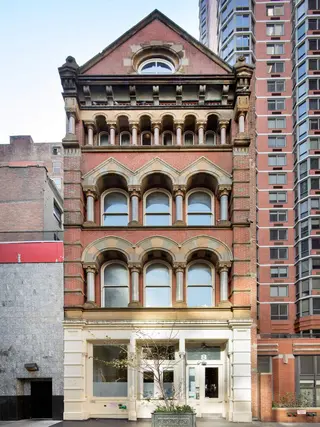 Carter Horsley
Carter HorsleyNov 15, 2017
Carter's Review
This lovely, 1915, 5-story, High Victorian Gothic-style building at 8 Thomas Street between Broadway and Church Street in TriBeCa was erected in 1875 for David A. Brown, a soap manufacturer, and has 4 condominium apartments.
It was designed by Jarvis Morgan Slade and was designated an individual city landmark in 1978. It was converted in 1984 to ground-floor commercial space and two art studios with apartments. In 2007, it was converted to condominium apartments by Ashnu International Corporation, which was headed by Nayan Parikh.
Bottom Line
A charming, small landmark building in the heart of TriBeCa with only a handful of duplex apartments.
Description
The building has a cast-iron façade that is painted white on its first floor and its sides have nicely rusticated piers on the lower three floors.
The second and third floors have three large, arched windows each with marble Ionic columns supported their large stone arched tops. The arches on the second floor are curved and those on the third floor are angled. The fourth floor has 6 six small windows with a similar but smaller treatment with columns above the lower piers.
The building has a bracketed cornice surmounted by a large, peaked roof with a large arched window surrounded by colored stones.
Amenities
The building has an elevator and permits cats and dogs.
Apartments
The duplex penthouse has three bedrooms and 3,197 square feet with a library and a 1,000-square-foot roof terrace and a 1,000-square-foot wine cellar and game room in the basement.
Apartment 1 is a three-bedroom triplex with a 40-foot-long living room with an open kitchen and a 19-foot-wide master bedroom on the first level with a 33-foot-long office and two rooms on the second level and a 19-foot-wide media room with a 17-foot-long dressing area on the third level.
A three-bedroom duplex has a 21-foot-long living room with a 13-foot-long open kitchen with an island and a master bedroom on the lower level and two bedrooms on the upper level.
Apartment 1B is a two-bedroom unit with a small vestibule that leads past an open kitchen to a 19-foot-long living/dining room flanked by the bedrooms and a building-wide patio.
History
The TriBeCa Citizen reprinted an article by Tom Miller at his fine website Daytonianinmanhattan.com about the building.
“The young Jarvis Morgan Slade learned his trade in the architectural offices of Edward H. Kendall. After opening his own business at 346 Broadway, the highly-talented Slade began making his mark on New York architecture. In 1875 the 23-year-old architect was given the commission by the New York Real Estate Association to design a store and loft building for the successful soap manufacturer, David S. Brown. The Association, organized by textile merchants to insure that the textile district remained intact, had recently purchased the former grounds of the New York Hospital. The proposed David S. Brown store would stand here on the newly extended Thomas Street. The soap company had been doing business since 1808 and, while not a national brand, did extensive business throughout New York and its neighboring states. The firm produced a range of products from Blizzard Soap, a laundry flake; David’s Prize Soap, a toilet soap; and Brown’s Barber Soap, a shaving soap used in the ubiquitous shaving mugs in barber shops and homes. By the time Slade began designing the new store, David S. Brown had two factories, on First Avenue and on Chrystie Street, a retail space at 299 Broadway and headquarters on Peck Slip. Completed in 1876, the young architect’s soap store is a Victorian delight. The influence of contemporaries such as Jacob Wrey Mould – responsible for much of Central Park’s fanciful architecture – Charles Eastlake and John Ruskin, combined with Slade’s own remarkable flair, resulted in a colorful Victorian Gothic treasure….The romantic and lively building was no doubt influential in Slade’s receiving many subsequent commissions. Tragically, within seven years the promising architect would be dead at the age of 30….By 1898, David S. Brown was gone from No. 8 Thomas Street and the wholesale woolen merchants W. S. Taylor & Bloodgood was doing business there….The day after Christman in 1910, the Bustanoby brothers – Andre, Jacques, Pierre and Louis – announced their intentions to install a quaint Frenchy café where bars of soap were once sold….The new café would be called the Cabaret des Beaux Arts. The venture would be short-lived. The brothers had a severe falling out with Louis leaving the business to run the restaurant in the Flatiron Building….By the end of 1912, the Caberet des Beaux Arts was no more. On March 17, 1948 shock waves hit the New York real estate market when former Manhattan Borough President Samuel Levy and real estate mogul Charles F. Noyes purchased nearly three entire downtown blocks from the Society of the New York Hospital. Included in the sale was No. 8 Thomas Street….Luckily, No. 8 Thomas Street was spared….”

- Condo built in 1915
- Converted in 2007
- Located in Tribeca
- 4 total apartments 4 total apartments
- 8 recent sales ($1.6M to $4.7M)
- Small Pets Allowed only
 6sqft delivers the latest on real estate, architecture, and design, straight from New York City.
6sqft delivers the latest on real estate, architecture, and design, straight from New York City.
